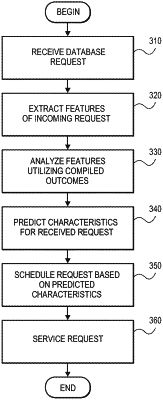| CPC H04L 67/1008 (2013.01) [G06F 9/5011 (2013.01); G06F 16/2455 (2019.01); G06N 20/00 (2019.01); H04L 43/0876 (2013.01); H04L 47/125 (2013.01); H04L 49/90 (2013.01); H04L 67/10 (2013.01); H04L 67/1001 (2022.05); H04L 67/1014 (2013.01); H04L 69/329 (2013.01); G06F 2209/5019 (2013.01)] | 20 Claims |

|
1. A method, comprising:
receiving, with one or more hardware processing devices, a plurality of database queries to be performed using resources associated with a database, each database query having an associated group of features;
analyzing, utilizing machine learning techniques, the group of features for each database query to collect query execution data observations about the plurality of database queries;
creating, utilizing machine learning techniques, a machine learning model based on the query execution data observations, the machine learning model comprising a function configured to predict a resource allocation of a subsequent database query;
predicting, with the machine learning model, a particular resource allocation for a particular subsequent query; and
providing, with the one or more hardware processing devices, resources to service the particular subsequent database query according to the particular resource allocation.
|